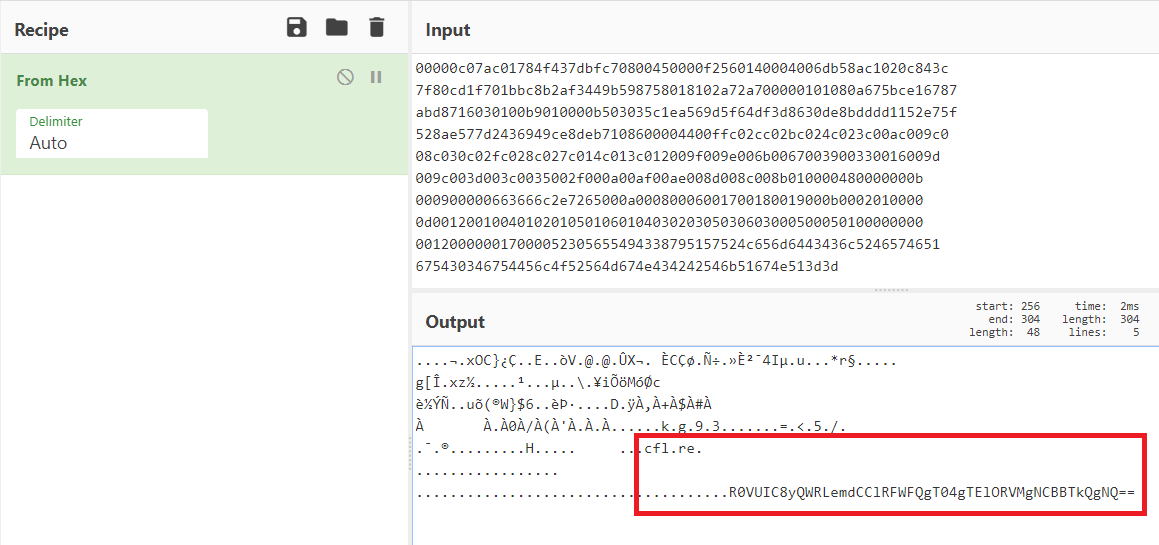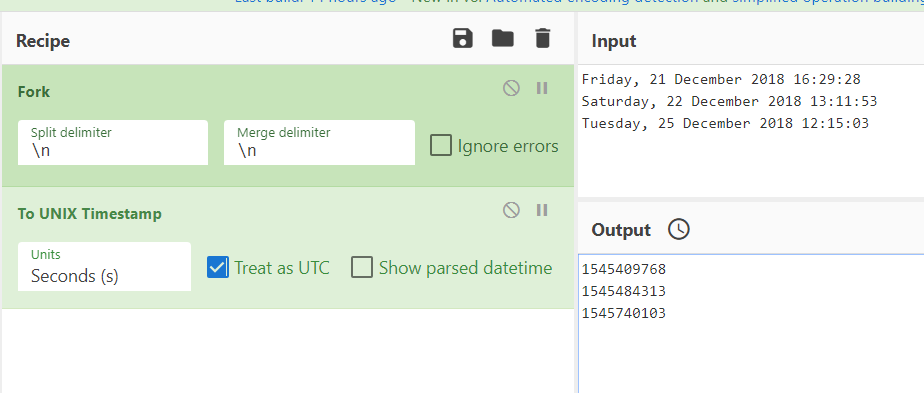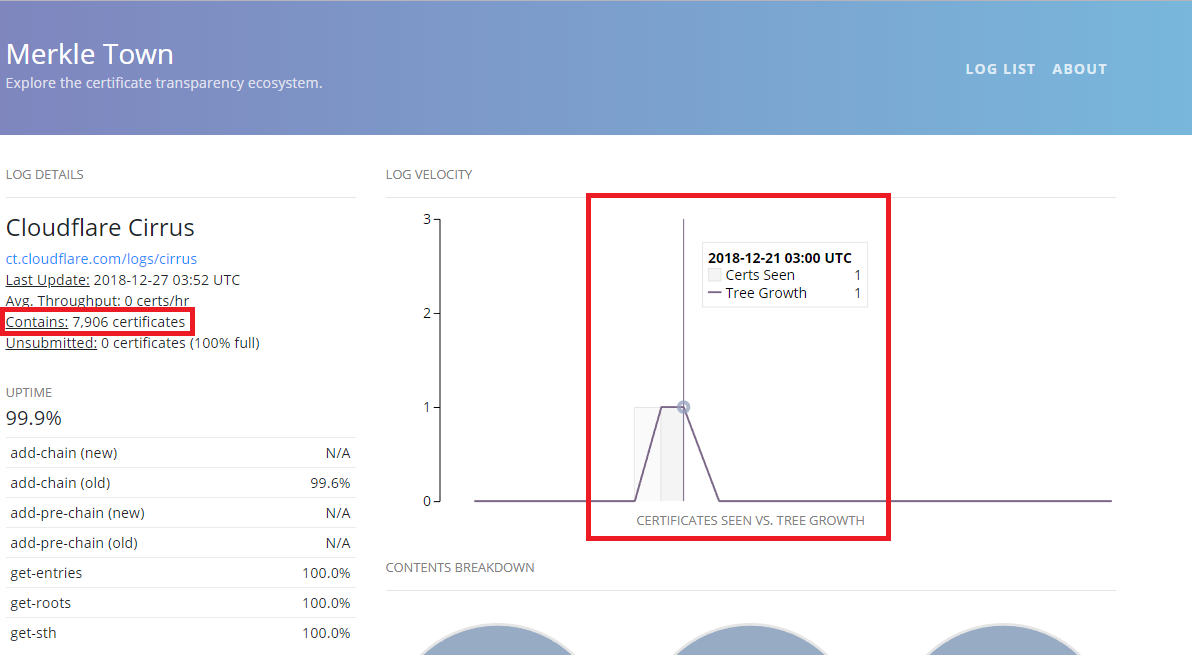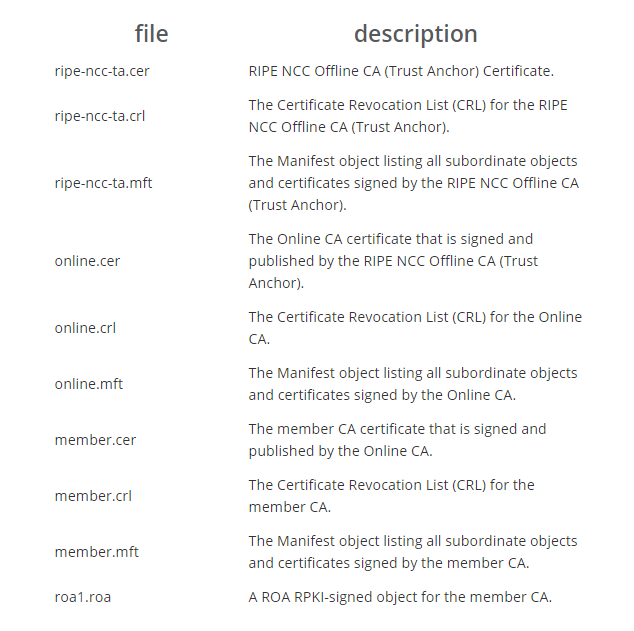
2019-01-04 10:24:15 Author: parsiya.net(查看原文) 阅读量:48 收藏
Cloudflare had a Christmas crypto(graphy) challenge. Here are my solutions. The first two questions were pretty easy but the 3rd sent me down on a rabbit hole. Apparently, only 15 people solved it which places me in the world top 15 cryptographers (that's how it works right?).
The packet is a raw ClientHello (not completely but let's not debate that). ClientHello is the first part in the 3-way TLS handshake (don't mix it up with the 3-way TCP handshake).
Dropping it into CyberChef and applying From Hex filter shows us an interesting payload. Supposedly SNI but I did not check the format of the packet.
SNI stands for Server Name Indication. It's a way for the client to tell a virtual host what certificate to use for communication. Read about it:
On the Cloudflare blog we can read about encrypting the SNI to prevent privacy leaks:
The result from Cyberchef looks like this:
....¬.xOC}¿Ç..E..òV.@.@.ÛX¬. ÈCÇø.Ñ÷.»È²¯4Iµ.u...*r§.....
g[Î.xz½.....¹...µ..\.¥iÕöMóØc
è½ÝÑ..uõ(®W}$6..èÞ·....D.ÿÀ,À+À$À#À
À À.À0À/À(À'À.À.À......k.g.9.3.......=.<.5./.
.¯.®.........H..... ...cfl.re.
.................
.....................................R0VUIC8yQWRLemdCClRFWFQgT04gTElORVMgNCBBTkQgNQ== From Hex applied to the payload
From Hex applied to the payload
Base64 decode the payload:
GET /2AdKzgB
TEXT ON LINES 4 AND 5Combine it with clf.re (included in the raw data) to get https://cfl.re/2AdKzgB which redirects to https://www.cloudflare.com/robots.txt.
# .__________________________.
# | .___________________. |==|
# | | ................. | | |
# | | ::[ Dear robot ]: | | |
# | | ::::[ be nice ]:: | | |
# | | ::::::::::::::::: | | |
# | | ::::::::::::::::: | | |
# | | ::::::::::::::::: | | |
# | | ::::::::::::::::: | | ,|
# | !___________________! |(c|
# !_______________________!__!
# / \
# / [][][][][][][][][][][][][] \
# / [][][][][][][][][][][][][][] \
#( [][][][][____________][][][][] )
# \ ------------------------------ /
# \______________________________/Answer: Lines 4 and 5 say Dear Robot be nice.
Convert each of those times into a Unix timestamp. We can use Cyberchef again:
 Dates converted to time
Dates converted to time
The hints say it's using TOTP w/o a secret. TOTP is a modified version HOTP that uses timestamps. Long story short, you use a shared secret to calculate an HMAC (SHA-1 by default) of counter and secret. Then convert the result to six digits for usage. The counter is the number of durations (usually 30 seconds) since the start (usually it's 0 epoch). This means each code will be valid for 30 seconds.
Cyberchef has a TOTP and HOTP module but it creates it does not support generation without a secret. If a secret is not provided, it will generate a random secret and use that.
We can use a Go package github.com/pquerna/otp/totp to test our theory. January 1st 2019 is 1546300800 and plugging it into the code gives us the result.
package main
import (
"fmt"
"time"
"github.com/pquerna/otp/totp"
)
func main() {
time1 := time.Unix(1545409768, 0)
fmt.Println(time1.UTC())
str1, _ := totp.GenerateCode("", time1)
fmt.Println(str1)
time2 := time.Unix(1546300800, 0)
str2, _ := totp.GenerateCode("", time2)
fmt.Println(str2)
}
Answer: 301554.
 Output of Go code
Output of Go code
I wasted five hours on this one.
Using the hints:
- Hint #0: Four or six? Probably six.
- Cloudflare supports both IPv4 and IPv6 addresses. We should be looking for IPv6 addresses.
- Hint #1: If only there was a way of listing only our IPs!
- IP addresses are here: https://www.cloudflare.com/ips/
- Only IPv6 addresses: https://www.cloudflare.com/ips-v6
- Hint #2: What is the only part of the ROA where we can hide information into?
- ROA has four fields: ASN, Prefix, Maximum Length, Trust Anchor (TA),
- They are using ASN.
- Hint #3: Subtract the reserve, the char will show itself.
- See below. We did not really need to do any subtracting.
Plugin IPv6 addresses into this website http://ripeval.labs.lacnic.net:8080/roas. You can also run a local version of it using https://github.com/RIPE-NCC/rpki-validator-3.
Searching for 2803:f800::/32 we get some interesting results:
 Funky looking ASNs
Funky looking ASNs
If you have looked at ASCII codex in Hex or Decimal long enough, you can see the last digits are printable Decimal ASCII characters.
97 a
98 b
111 o
114 r
118 vThis doesn't make any sense. So I thought maybe we need to subtract 42 from them (subtract the reserve in the hints). Which gives us:
97 a 55 U
98 b 56 V
111 o 69 E
114 r 72 H
118 v 76 LThis does not make any sense either. Now, look at the prefixes. They end with a single digit from 1 to 5. Sorting by prefix we get bravo or VHULE if you do the subtracting. I went with bravo.
I wasted five hours going around the internet for the third challenge. The first three hints were easy. The whole challenge up to that moment had taken only five minutes (that's not a brag, it's very easy). But then I got stuck. Note the solution prefixes do not show up in any of the following places.
So Route Origin Authorisation or ROA is an object that is signed by a CA. It's using the x509 ecosystem and five root CAs to sign these announcements (one for each region). This supposedly reduces BGP hijacking. I do not know enough to give you a good explanation so please read their blog post and other resources:
Cloudflare Cirrus
My train of thought was "Ok, they are signing certificate like objects" (ROAs are not certificates but they are signed). Cloudflare has a certificate transparency log for ROAs called Cirrus at https://ct.cloudflare.com/logs/cirrus.
Supposedly, you can get the logs but how? The page does not have anything. 15 minutes of searching and I realized the get-entries and other items in the left side bar are REST style endpoints. There's an RFC at https://tools.ietf.org/html/rfc6962.
Jump down to page 20 to see get-entries:
GET https://<log server>/ct/v1/get-entries?start=1234&end=5678
Looking at their status page I saw two certificates were recently enrolled (20th and 21st December 2018). These must be the new certificates, right?
 New certificates added to the Cirrus certificate transparency log
New certificates added to the Cirrus certificate transparency log
There were 7906 certificates in the log. We can access each of the individual entries or search for ranges, so to get the last six entries we can use this GET request:
Which gives us this big JSON file, the keys are discussed in the RFC on the same page. Unfortunately, neither of them are the certificate:
leaf_inputis the Merkle Tree.extra_datais the chain.
We can decode them from base64 to get the underlying item but it's not what we want.
gortr
Cloudflare is a Go shop and they have this utility: https://github.com/cloudflare/gortr.
I do not know enough to tell you what it does but it has a link to this file:
It has records like this:
{"prefix":"157.119.101.0/24","maxLength":24,"asn":"AS3177","ta":""}I looked up Cloudflare's IPv6 addresses to find the ASNs. Nothing looked out of the ordinary.
BGPMON Whois
I also stumbled upon this blog:
We can get ROA information from this whois server. Plugging the prefixes from the rpki.json file or any other place we can see the results:
$ whois -h whois.bgpmon.net 2400:cb00:151::/48
% This is the BGPmon.net whois Service
% You can use this whois gateway to retrieve information
% about an IP adress or prefix
% We support both IPv4 and IPv6 address.
%
% For more information visit:
% http://bgpmon.net/bgpmonapi.php
Prefix: 2400:cb00:151::/48
Prefix description: 101 Townsend Street, San Francisco, California 94107, US
Country code: US
Origin AS: 13335
Origin AS Name: Cloudflare Inc
RPKI status: ROA validation successful
First seen: 2018-12-21
Last seen: 2018-12-26
Seen by #peers: 57There's a typo in line 4 (adress) that is bugging me but we get some info. Next, we can plug the ASN and prefix into this other command:
$ whois -h whois.bgpmon.net " --roa 13335 2400:cb00:151::/48"
0 - Valid
------------------------
ROA Details
------------------------
Origin ASN: AS13335
Not valid Before: 2018-11-29 20:32:10
Not valid After: 2019-07-30 00:00:00 Expires in 214d16h22m30s
Trust Anchor: rpki.apnic.net
Prefixes: 2400:cb00:11::/48 (max length /48)
2400:cb00:2048::/48 (max length /48)
2400:cb00:27::/48 (max length /48)
2400:cb00:120::/48 (max length /48)
2400:cb00:42::/48 (max length /48)
2400:cb00:174::/48 (max length /48)You don't even need the first command. Simply send the second command with any ROA and the output will correct you:
$ whois -h whois.bgpmon.net " --roa 123456 2400:cb00:151::/48"
2 - Not Valid: Invalid Origin ASN, expected 13335I plugged in Cloudflare's IPv6 IP and could not find anything fishy there. The solution prefixes are not found here either.
$ whois -h whois.bgpmon.net 2803:f800:cfcf:cfcf:cfcf:cfcf:cfcf:3/128
Prefix not foundSeems like we can also use this whois server:
https://www.ripe.net/analyse/archived-projects/ris-tools-web-interfaces/riswhois
$ whois -h riswhois.ripe.net 2400:cb00:151::/48 % This is RIPE NCC's Routing Information Service % whois gateway to collected BGP Routing Tables, version2.0 % IPv4 or IPv6 address to origin prefix match % % For more information visit http://www.ripe.net/ris/riswhois.html % % Connected to backend ris-whois12.ripe.net route6: 2400:cb00:151::/48 origin: AS13335 descr: CLOUDFLARENET - Cloudflare, Inc., US lastupd-frst: 2018-10-03 06:11Z 2001:478:124::241@rrc16 lastupd-last: 2018-12-26 23:34Z 2001:7f8:4::9471:1@rrc01 seen-at: rrc00,rrc01,rrc03,rrc04,rrc05,rrc06,rrc07,rrc10,rrc11,rrc12,rrc13,rrc14,rrc15,rrc19,rrc20,rrc21,rrc23 num-rispeers: 211 source: RISWHOIS
And again, nothing there for the fishy prefixes:
$ whois -h riswhois.ripe.net 2803:f800:cfcf:cfcf:cfcf:cfcf:cfcf:3/128
% This is RIPE NCC's Routing Information Service
% whois gateway to collected BGP Routing Tables, version2.0
% IPv4 or IPv6 address to origin prefix match
%
% For more information visit http://www.ripe.net/ris/riswhois.html
%
% Connected to backend ris-whois04.ripe.net
% No entries foundrsync://rpki.ripe.net/repository/
Validators use rsync to get all the certificates and ROAs. We can get them manually too.
$ rsync -av rsync://rpki.ripe.net/repository/ .The v switch prints everything, and there are a ton of files being downloaded so I removed it. The result is this huge lot of certificates, ROAs, CRLs, and other stuff. Seriously, there were 40000+ files in 14000 folders. There was no way that I could parse all of these and figure out the solution so I gave up there.
│ 2a7dd1d787d793e4c8af56e197d4eed92af6ba13.cer
│ ripe-ncc-ta.crl
│ ripe-ncc-ta.mft
│
├───aca
│ HGp1AESLbyiopScGy7yW4b6s_T4.cer
│ Kn3R14fXk-TIr1bhl9Tu2Sr2uhM.crl
│ Kn3R14fXk-TIr1bhl9Tu2Sr2uhM.mft
│
└───DEFAULT
│ 0-sjfvx8LHPCPmrwyaX3vz51CQw.cer
│ 0-SVCv6AXz7c9M8RLlcYO_0ALFY.cer
│ 01qjZwczxpcrS5FhVwvd6aIPlTU.cer
│ 01Z_Y4Iw6KiE7J_X-uTLSRwv_eU.cer
│ 03l7bVyOqC4v44GDY6-4JscZKOc.cer
│ 03z5DDj2eKrXwsVXQmiNpZ9pzis.cer
│ 04kZ4OLyGlSKdZHdOvDg_k7YO_g.cer
│ 05BnEzOQAuBsZwwCI4CEJmVs0L4.cerIf you wanna know what these files are, navigate to this page https://www.ripe.net/publications/docs/ripe-549#Repositories and scroll up.
 Description of files downloaded via rsync
Description of files downloaded via rsync
I wanted to parse the ROA files and see if I can grab any information from inside them but I gave up. There might be some support here:
Seems like that is a fork of the x509 package aimed for working with certificate transparency logs.
如有侵权请联系:admin#unsafe.sh